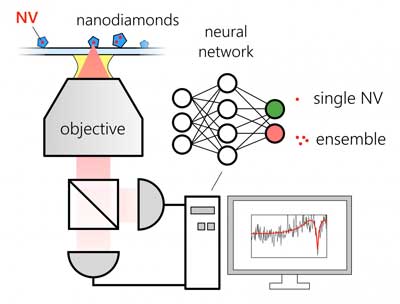| Sep 11, 2020 | |
New machine learning-assisted method rapidly classifies quantum sources(Nanowerk News) For quantum optical technologies to become more practical, there is a need for large-scale integration of quantum photonic circuits on chips. |
|
| This integration calls for scaling up key building blocks of these circuits - sources of particles of light - produced by single quantum optical emitters. | |
| Purdue University engineers created a new machine learning-assisted method that could make quantum photonic circuit development more efficient by rapidly preselecting these solid-state quantum emitters. | |
| The work is published in the journal Advanced Quantum Technologies ("Rapid Classification of Quantum Sources Enabled by Machine Learning"). | |
 |
|
| Researchers trained a machine to recognize promising patterns in single-photon emission within a split second. (Image: Simeon Bogdanov) | |
| Researchers around the world have been exploring different ways to fabricate identical quantum sources by "transplanting" nanostructures containing single quantum optical emitters into conventional photonic chips. | |
| "With the growing interest in scalable realization and rapid prototyping of quantum devices that utilize large emitter arrays, high-speed, robust preselection of suitable emitters becomes necessary," said Alexandra Boltasseva, Purdue's Ron and Dotty Garvin Tonjes Professor of Electrical and Computer Engineering. | |
| Quantum emitters produce light with unique, non-classical properties that can be used in many quantum information protocols. | |
| The challenge is that interfacing most solid-state quantum emitters with existing scalable photonic platforms requires complex integration techniques. Before integrating, engineers need to first identify bright emitters that produce single photons rapidly, on-demand and with a specific optical frequency. | |
| Emitter preselection based on "single-photon purity" - which is the ability to produce only one photon at a time - typically takes several minutes for each emitter. Thousands of emitters may need to be analyzed before finding a high-quality candidate suitable for quantum chip integration. | |
| To speed up screening based on single-photon purity, Purdue researchers trained a machine to recognize promising patterns in single-photon emission within a split second. | |
| According to the researchers, rapidly finding the purest single-photon emitters within a set of thousands would be a key step toward practical and scalable assembly of large quantum photonic circuits. | |
| "Given a photon purity standard that emitters must meet, we have taught a machine to classify single-photon emitters as sufficiently or insufficiently 'pure' with 95% accuracy, based on minimal data acquired within only one second," said Zhaxylyk Kudyshev, a Purdue postdoctoral researcher. | |
| The researchers found that the conventional photon purity measurement method used for the same task took 100 times longer to reach the same level of accuracy. | |
| "The machine learning approach is such a versatile and efficient technique because it is capable of extracting the information from the dataset that the fitting procedure usually ignores," Boltasseva said. | |
| The researchers believe that their approach has the potential to dramatically advance most quantum optical measurements that can be formulated as binary or multiclass classification problems. | |
| "Our technique could, for example, speed up super-resolution microscopy methods built on higher-order correlation measurements that are currently limited by long image acquisition times," Kudyshev said. |
| Source: Purdue University | |
|
Subscribe to a free copy of one of our daily Nanowerk Newsletter Email Digests with a compilation of all of the day's news. |
